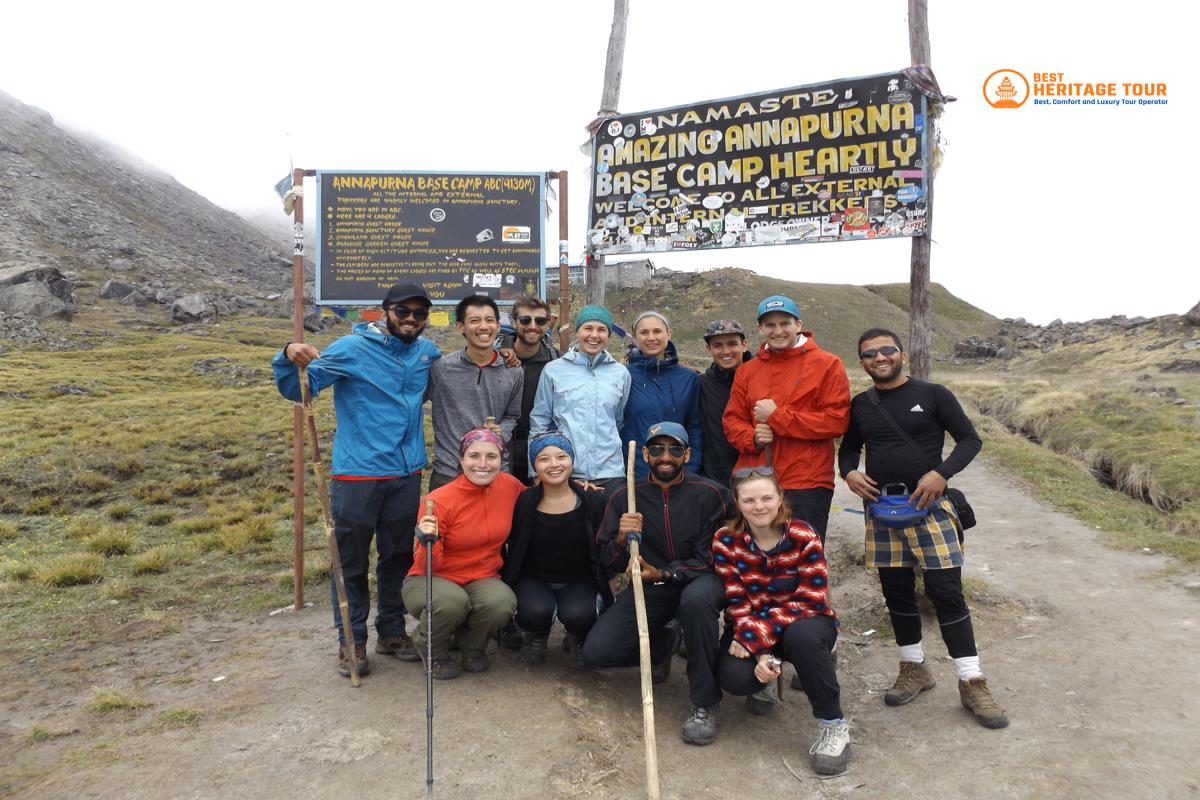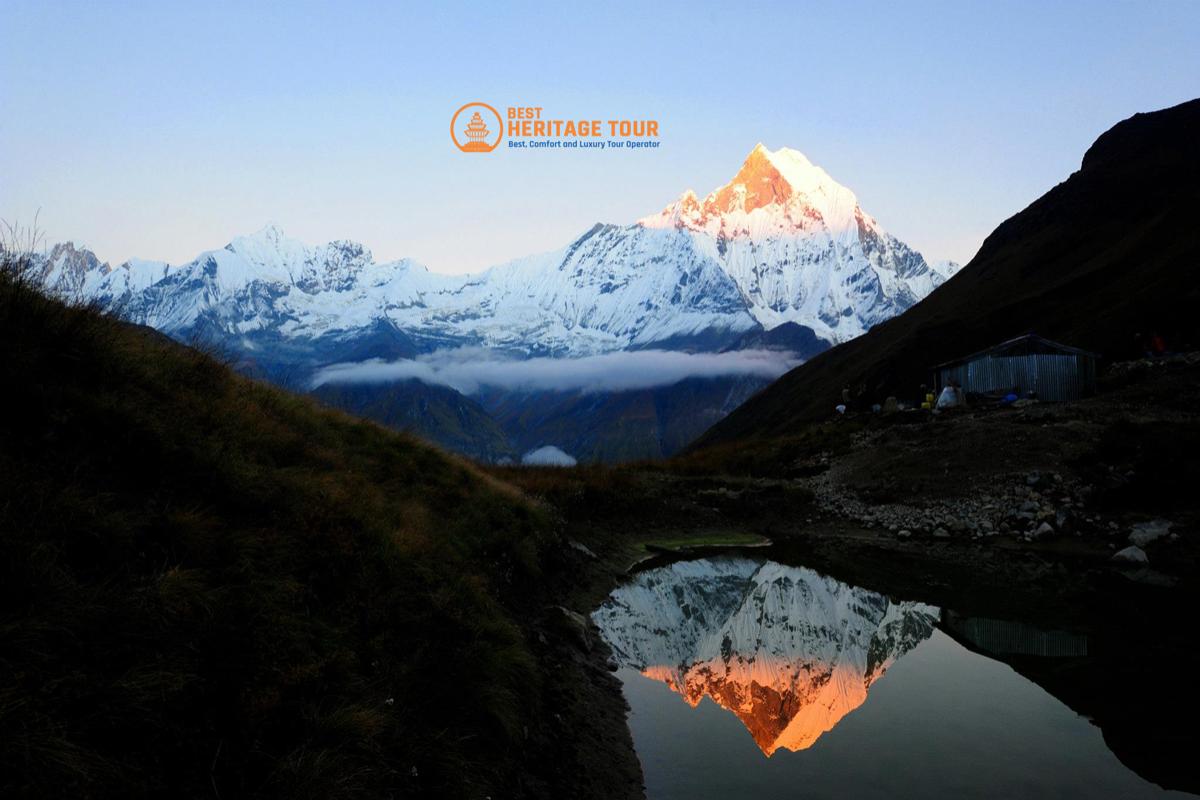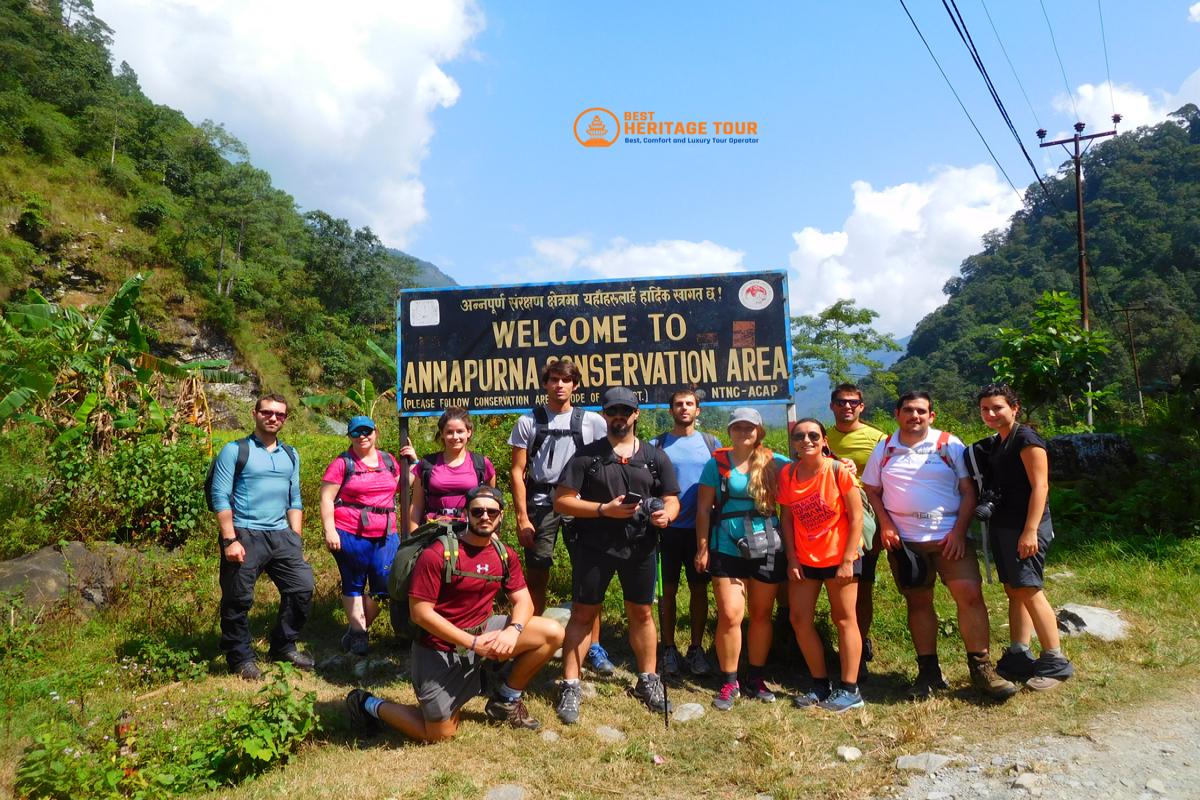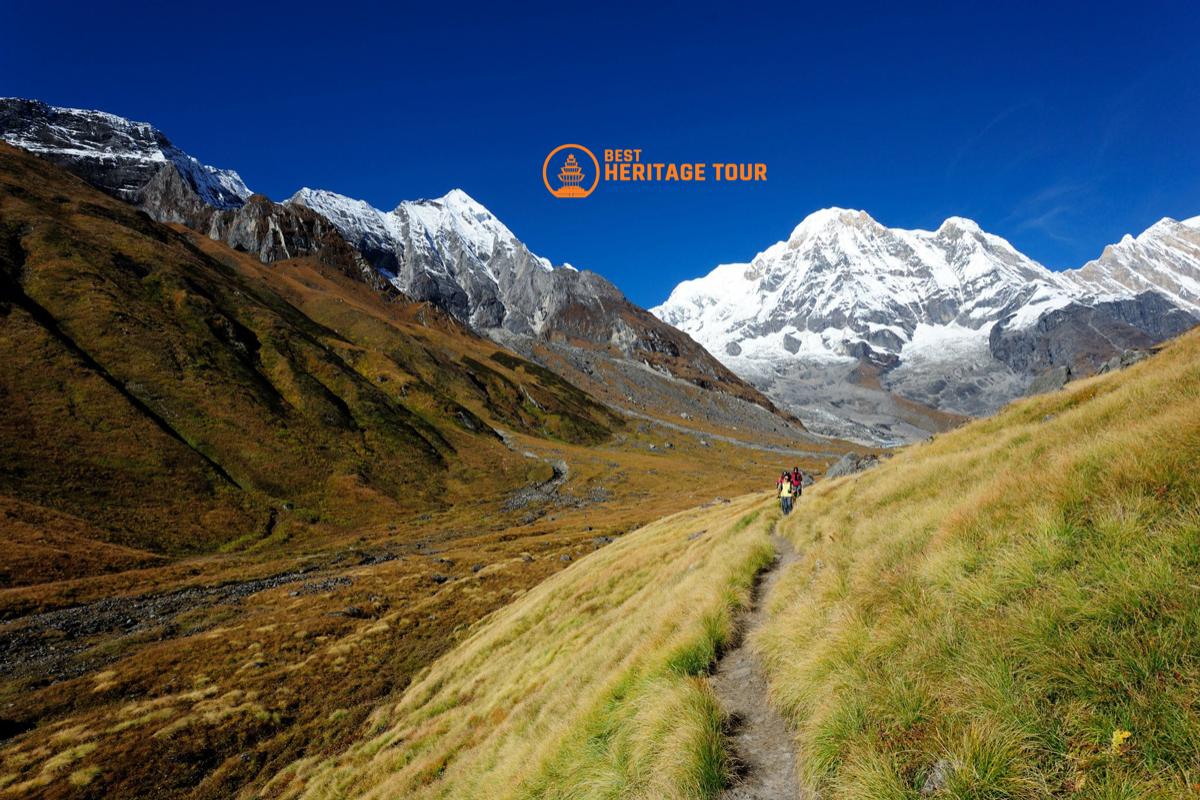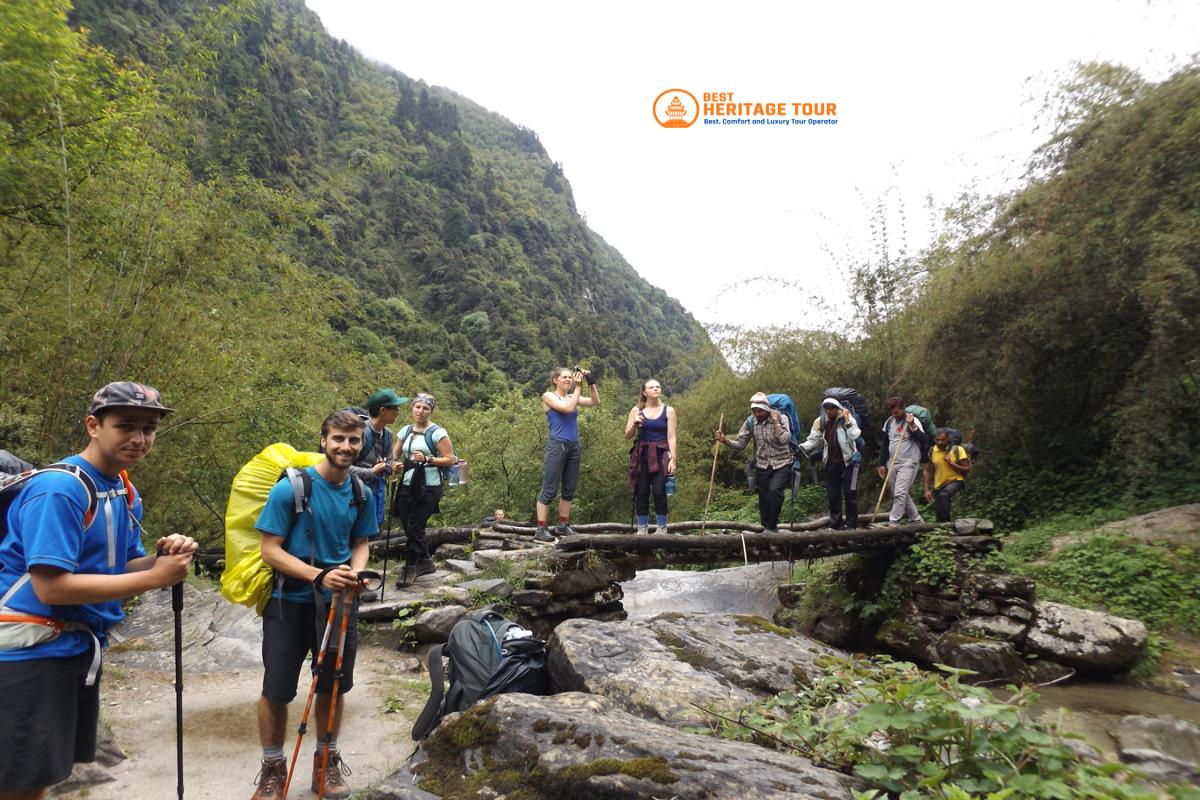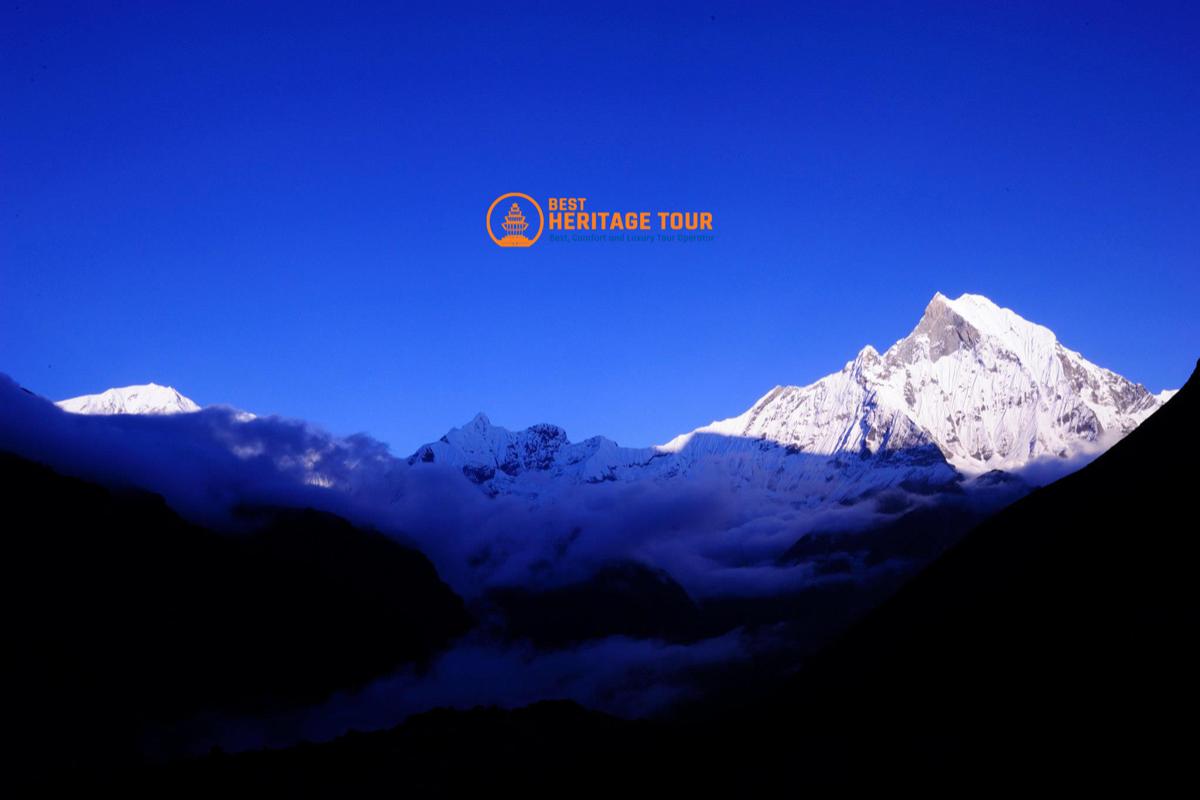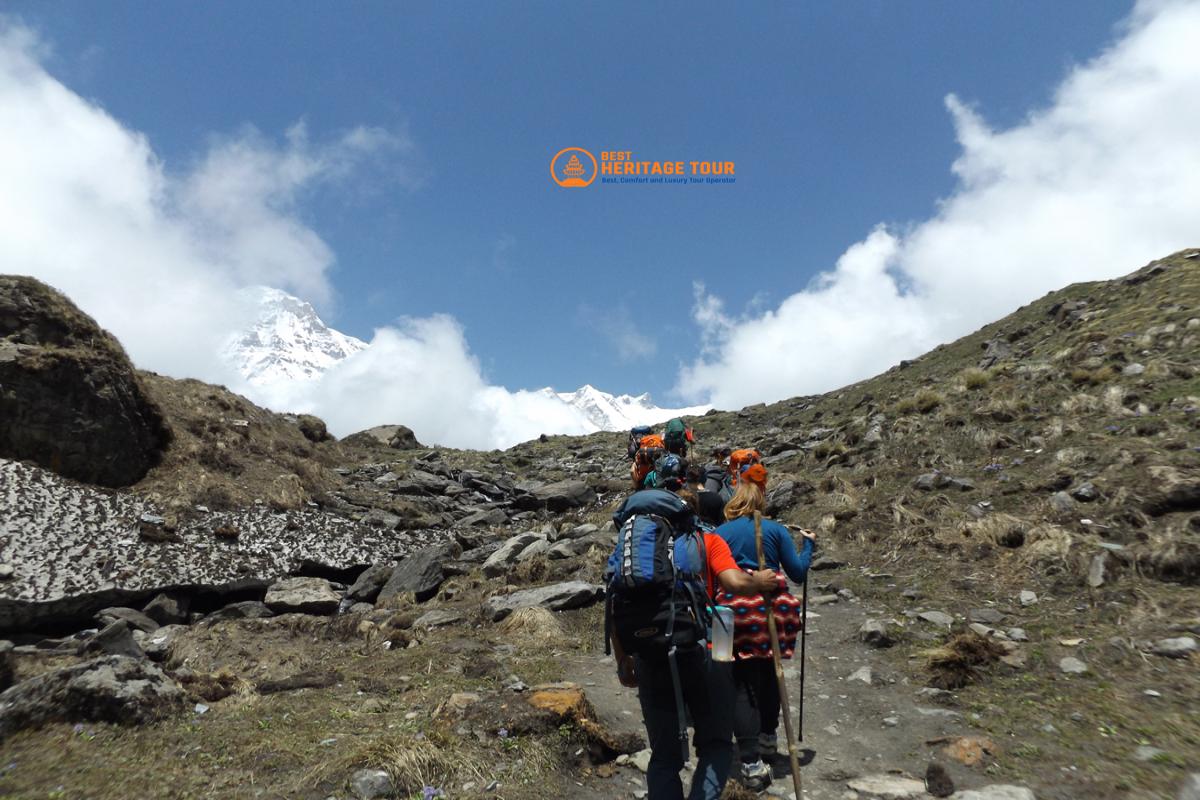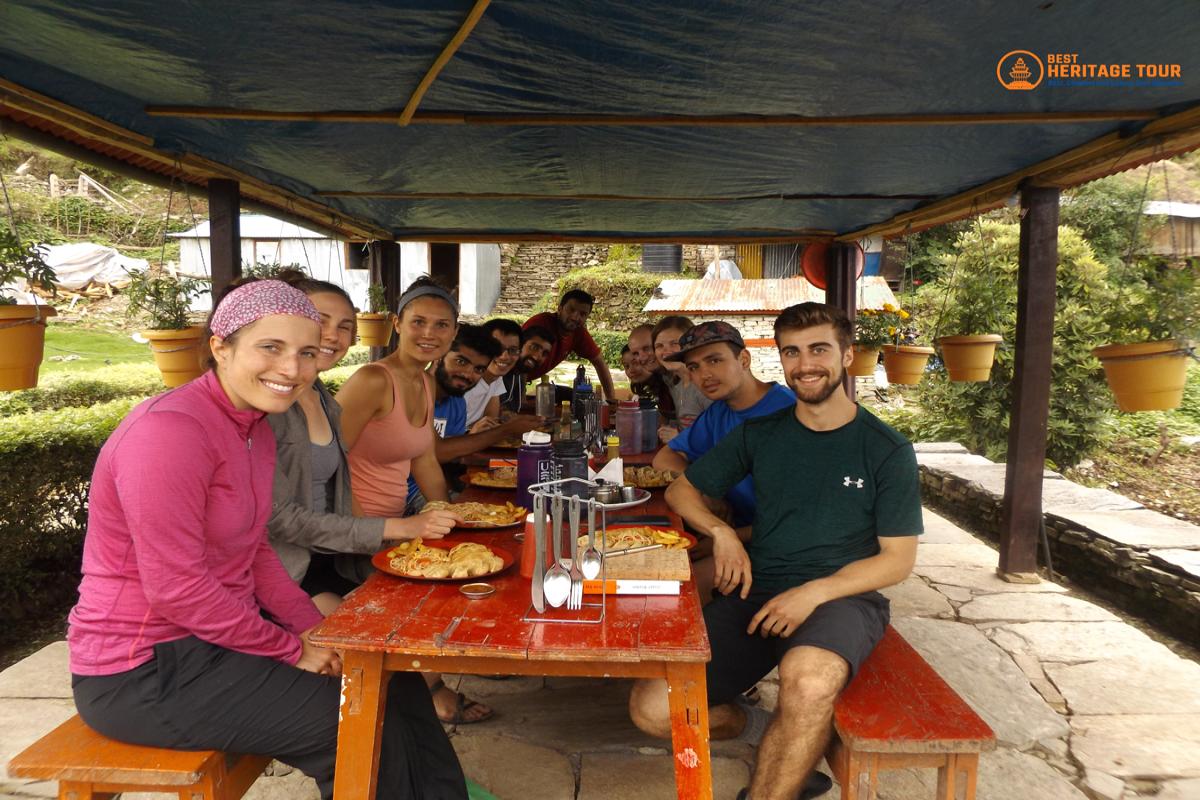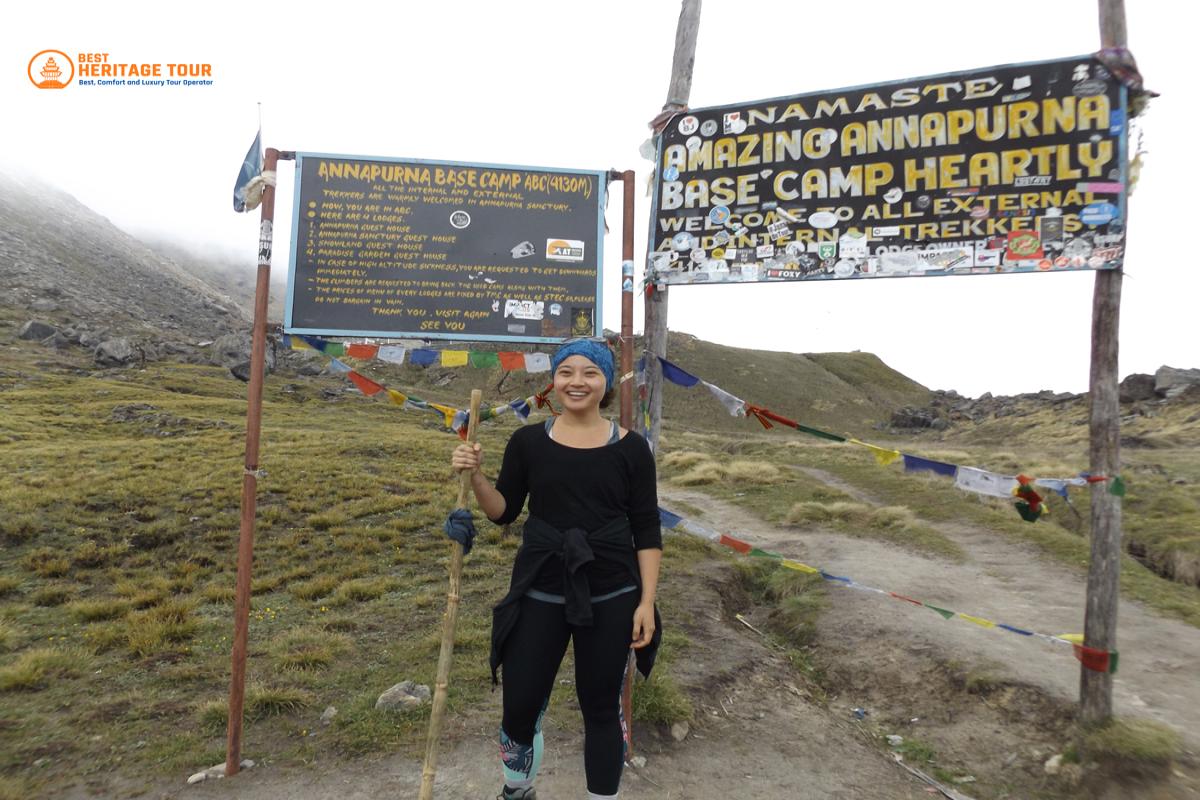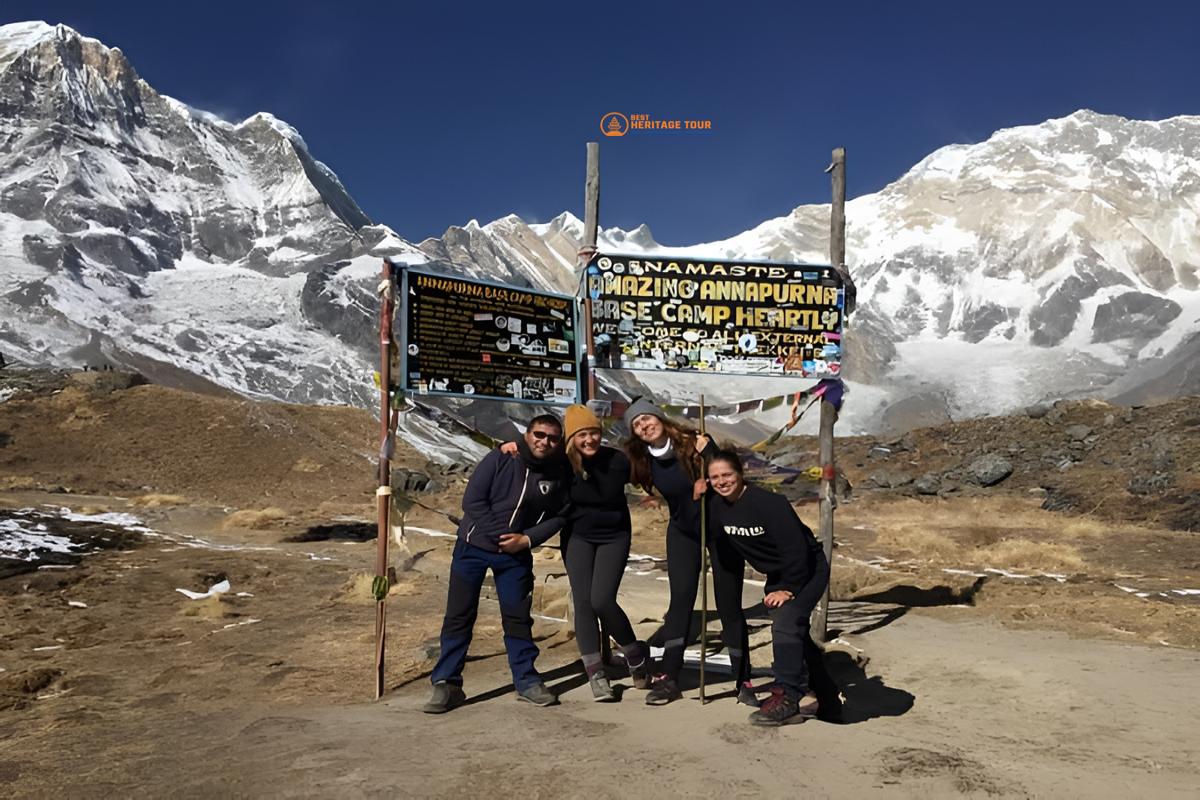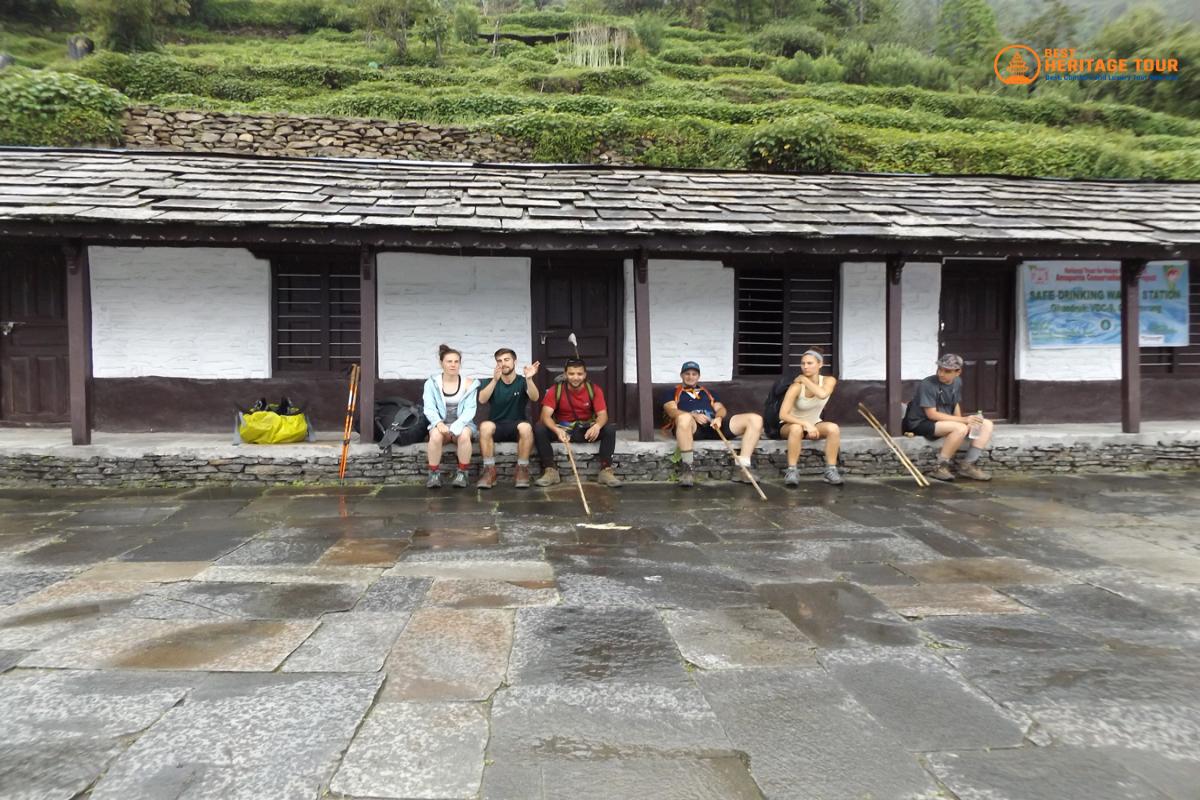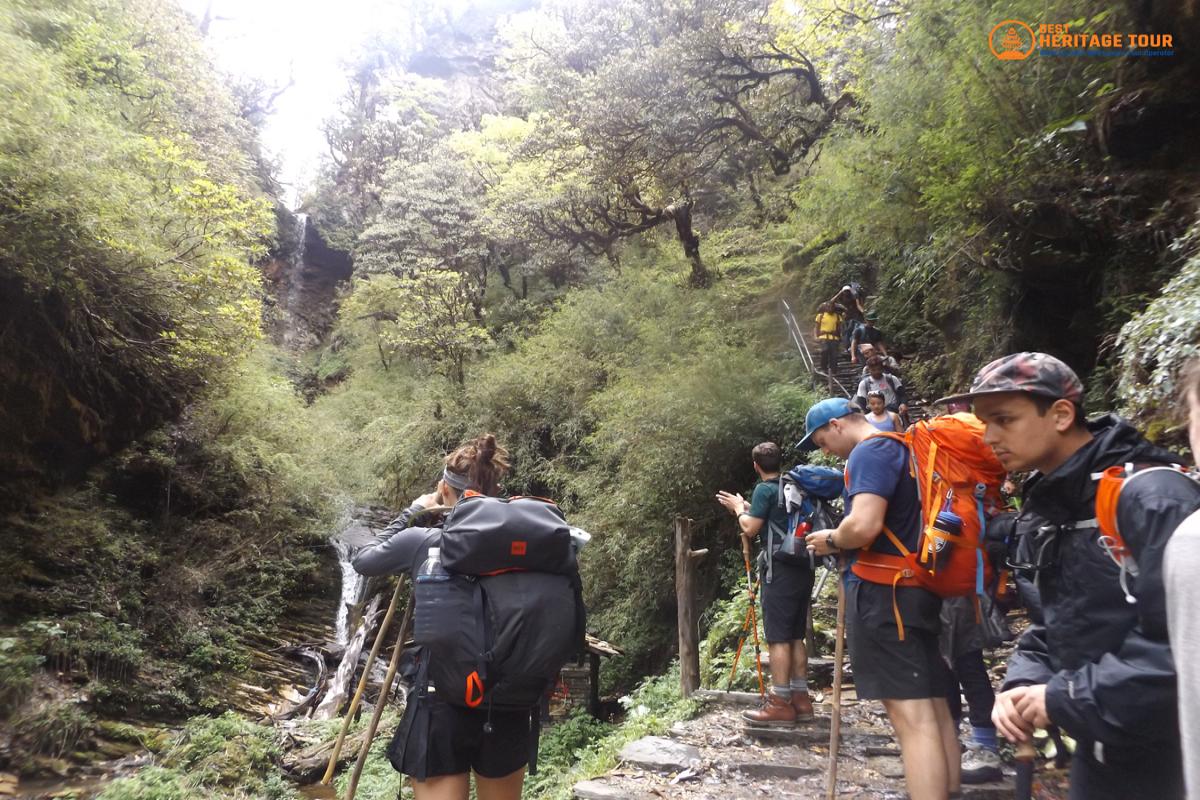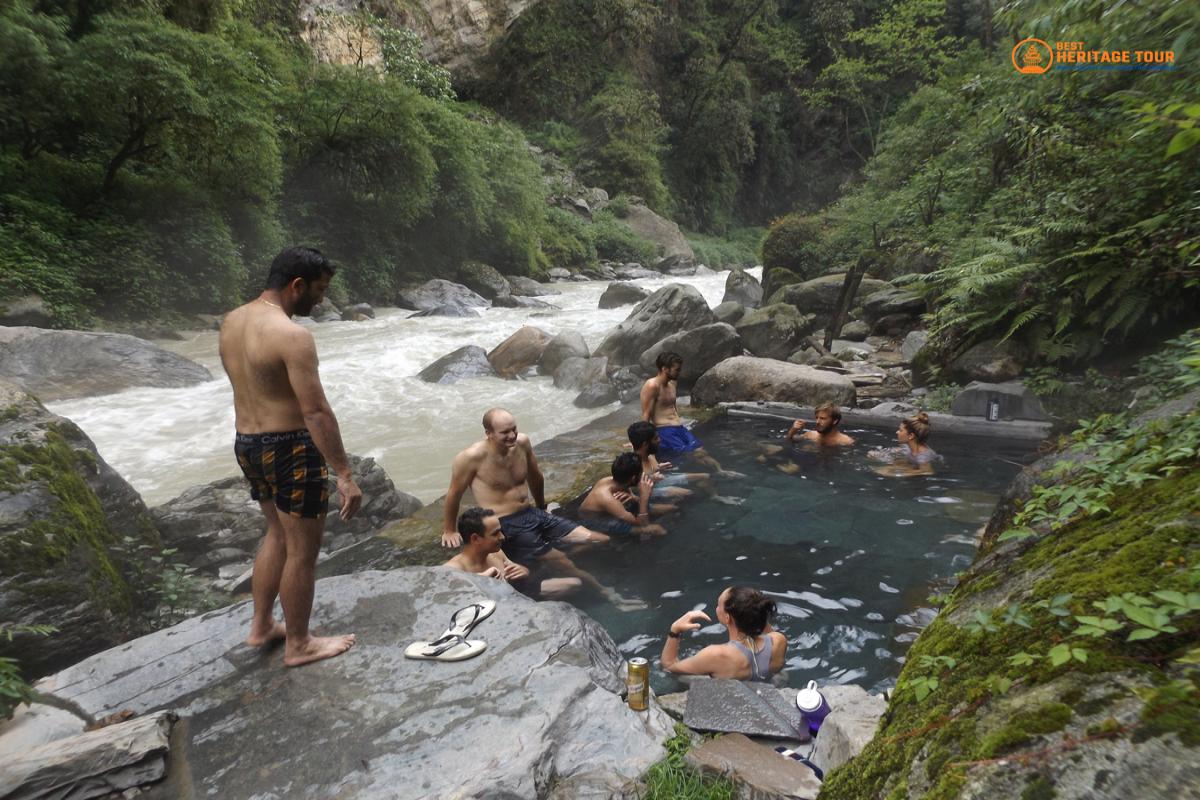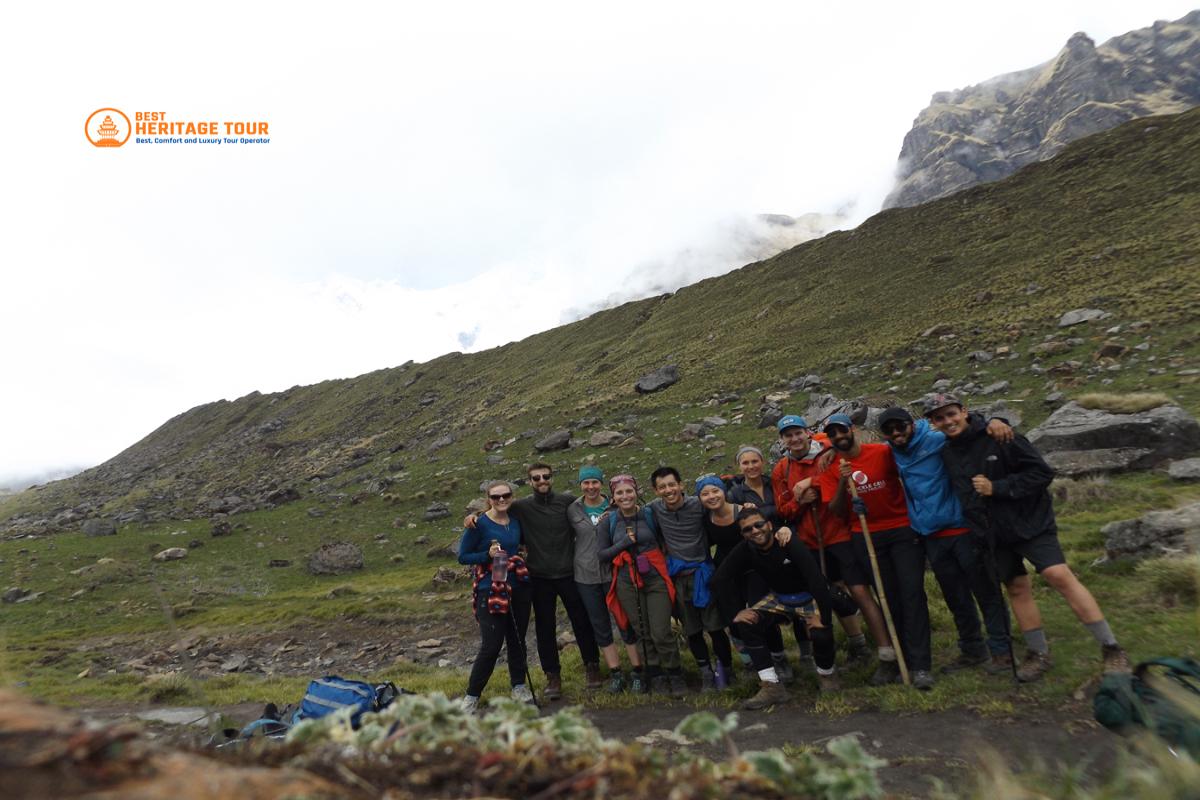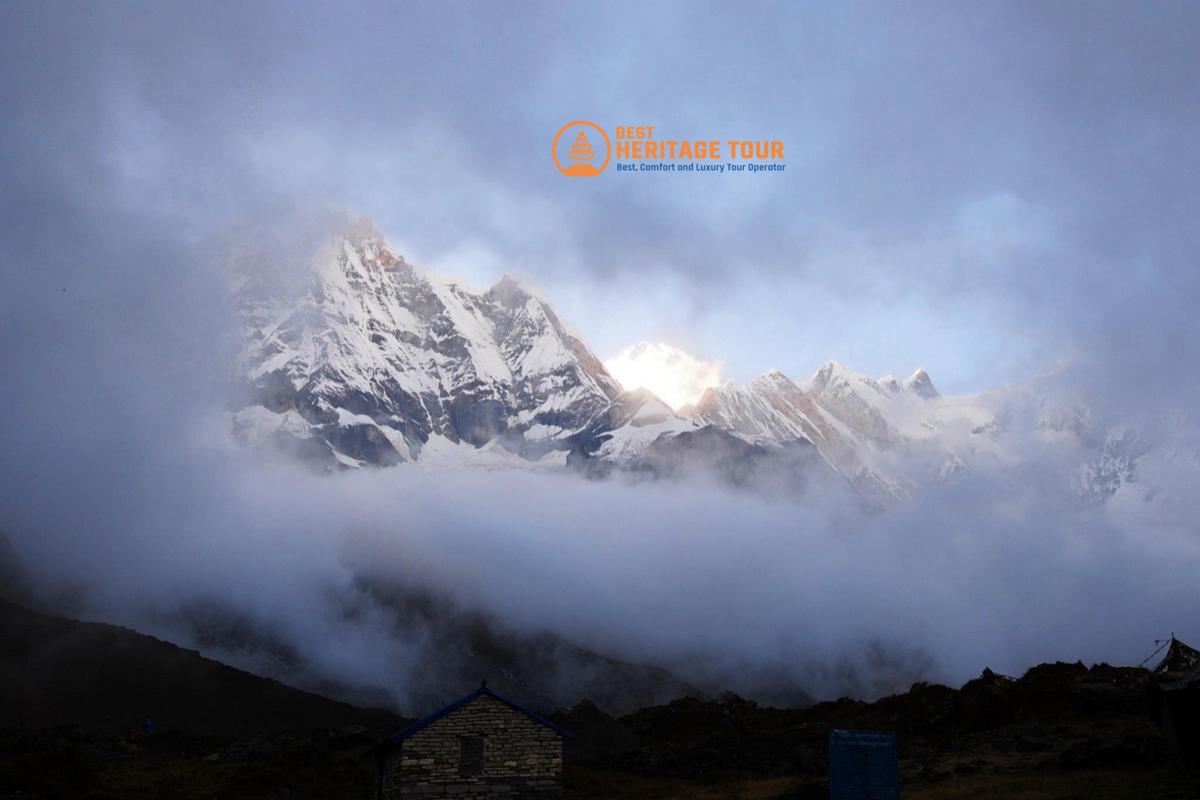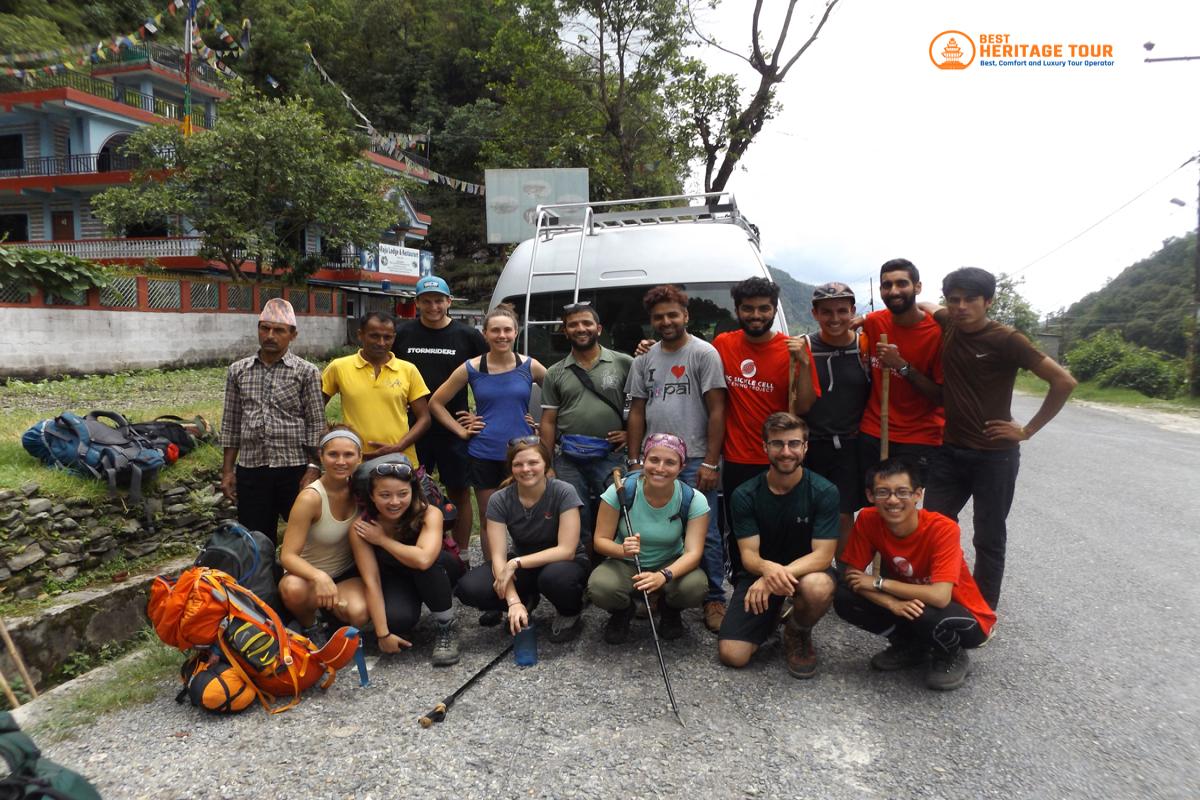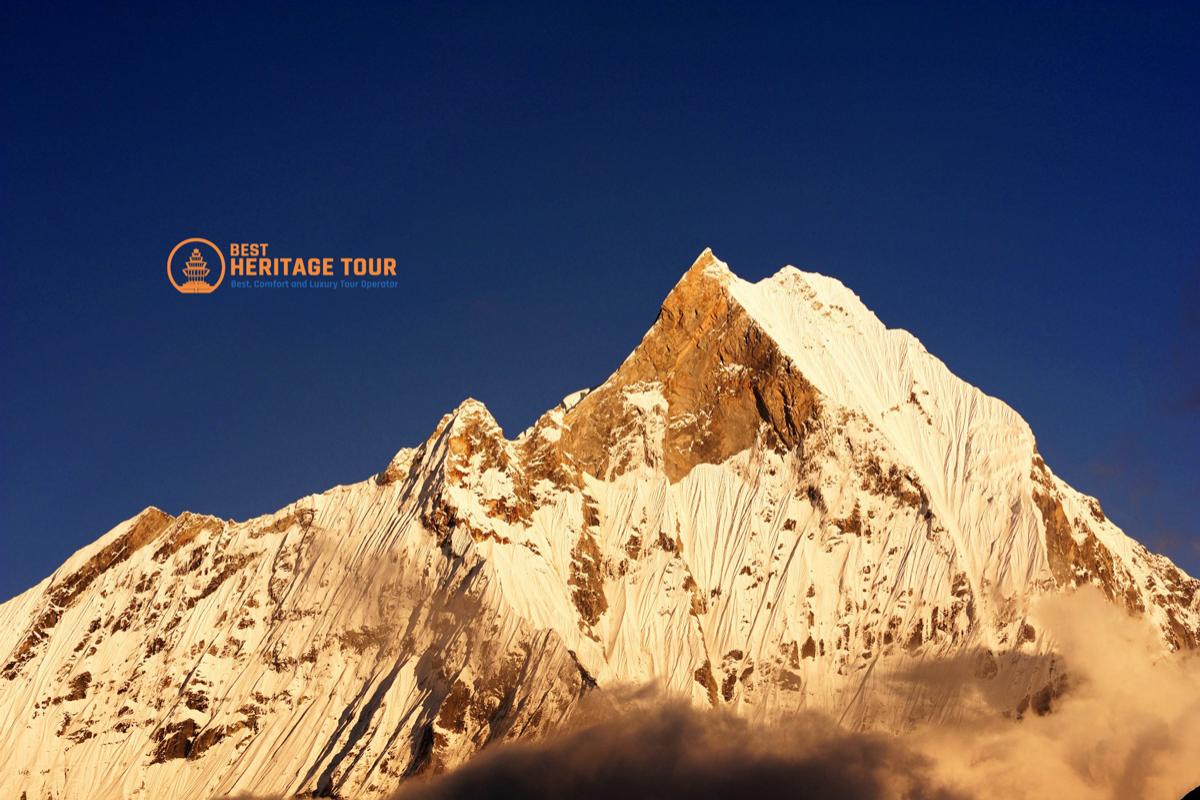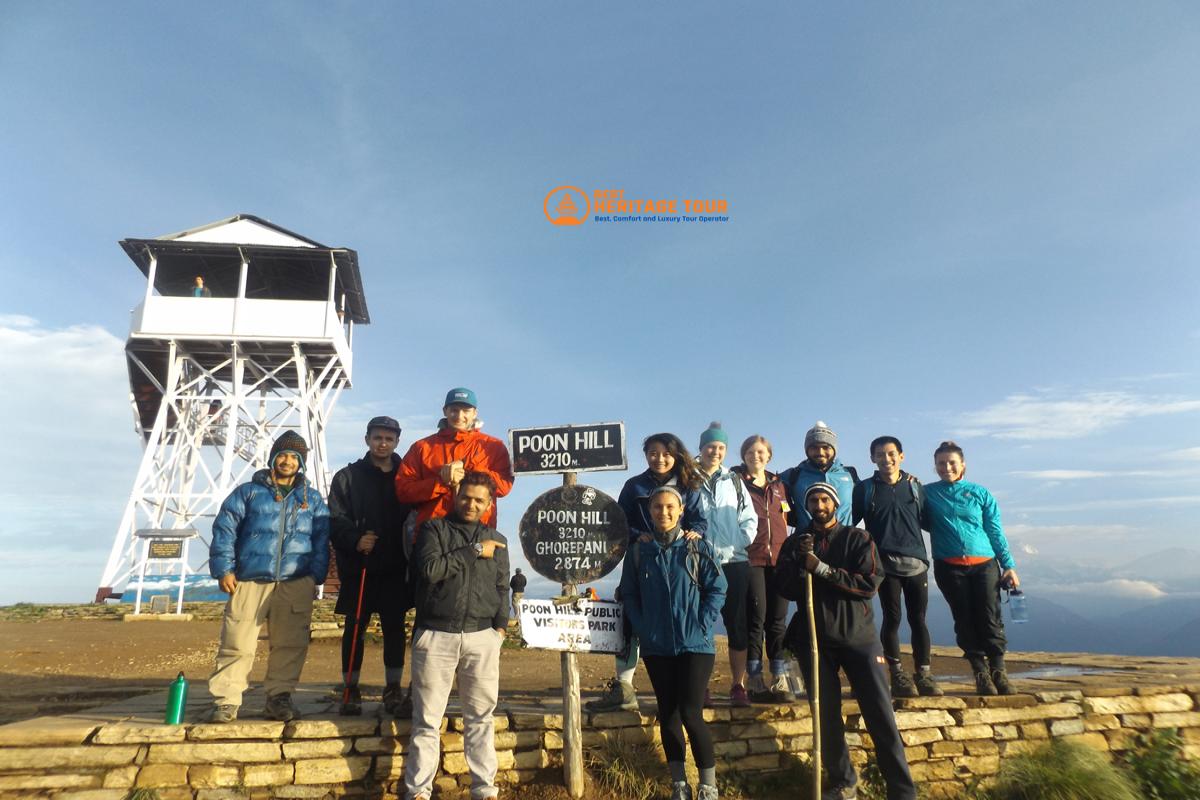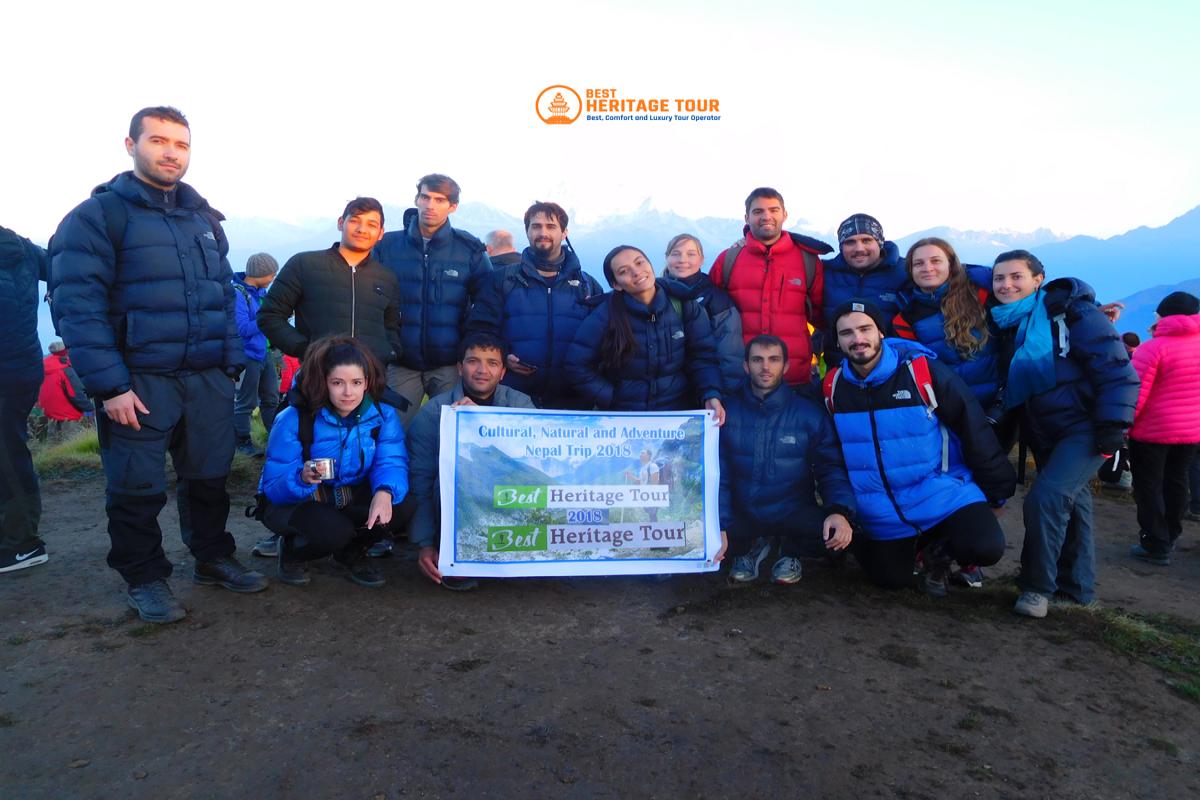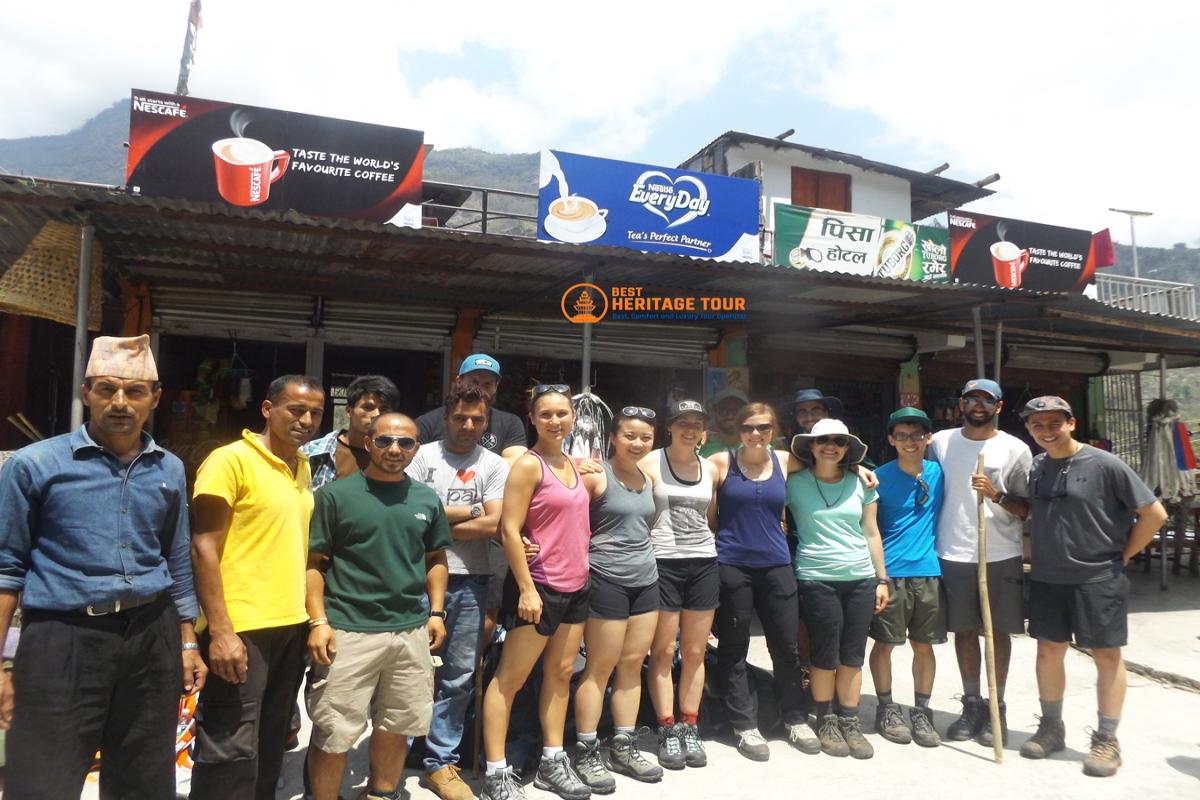Annapurna Base camp Trek - 11 Days
Insight on Annapurna Base Camp Trek
Annapurna Base Camp trek is one of the most beautiful treks in the world, with diverse climates, varied landscapes and culturally rich villages. From Annapurna Base Camp, you can enjoy breathtaking views of Fishtail, Hiunchuli, Annapurna massif, Dhaulagiri, Tilicho, Pisang, Punda Danda and many other peaks. Along the way, visit the famous Poon Hill lookout and relax in the naturally heated pools of Jinu Danda.
Trip at a Glance
Highlights of Annapurna Trekking in Nepal
- Pokhara Tourist Center
- Sunrise over the Annapurna range – including Dhaulagiri I (8,167 m), Annapurna I (8,091 m) and Nilgiri (7,061 m) from spot point Poon Hill.
- Annapurna Base Camp (4,130m)
- Rich flora and fauna
- Hot springs at Jinu Danda
- Stunning views of Hiunchuli, Annapurna South Annapurna I, Kangsar, Gangapurna, Annapurna III and Machhapuchhre
- Beautiful villages and farmlands at Ghandrank
- Insight into rural life in Nepal
Benefits of ABC Trek with Best Heritage Tours
- Free airport pickup and drop services on arrival and departure from your hotel with personnel transport
- Online travel consultation after booking confirmation
- Easy booking and reservation system
- Numerous communication channels (E-mail, WhatsApp, Facebook, Viber, Skype, Zoom)
- Phone contact 24/7, +977-9851149197
- Easy payment system.
- Available of luggage storage service without any cost during the trek
- Pulse oximeter to monitor blood oxygen saturation at high altitudes and detect early signs of altitude sickness and other health risks
- Medical equipment
- Provided sleeping bag and down jacket (if you don't have your own)
Annapurna Base Camp Comprehensive Trek
The ABC Trekking journey starts with an early morning bus transfer from Kathmandu to Pokhara. Pokhara is the tourist center of Nepal and you will surely be impressed by the beauty of Pokhara. From Pokhara (820m) you can enjoy a magnificent view of many mountains and a wonderful lake. Day 2 starts with a drive from Pokhara to Tikhedhunga via Birethanti (1,039m). The actual trek starts from Tikhedhunga. From there, you walk along the Modi River through the rice fields to your destination for the day, Ulleri (1,540m).
The next day's hike takes you to Ghorepani (2,860m). From Ghorepani you can get a great view of the Annapurna massif, Dhaulagiri, Tukche, Dhampus, Nilgiri, Barash Shikhar and Machhapuchhre (Fishtail).
On the very fourth day,you will reach the Poon Hill Viewpoint. To make the most of Poon Hill (3,210m), wake up early and trek to Poon Hill to watch the dawn from above the 32+ mountain ranges of Annapurna, Dhaulagiri and Nilgiri. After enjoying the spectacular views of Poon Hill, drive to Tadapani (2,630m) where you will spend the night.
After an overnight stay in Tadapani, leave Tadapani early in the morning and head towards Chomrong (2,165m). The trail passes through Ghandruk and descends to the Kirumrong River and continues the trek to Chomrong, a popular overnight stop for ABC trekkers.
The next day, wake up in Chomrong, have breakfast and start your hike to the Himalayan range (2,890m). The trail follows the Chomrong River through picturesque villages, ascends to the Modi River Valley and reaches the Himalayas where we spend the night.
On the seventh day we leave the Himalayas and trek to Annapurna Base Camp (ABC). Annapurna Base Camp is located at an altitude of 4,130m and offers spectacular views of the glaciers, Hiungchuli, Annapurna South, Annapurna I (8,097m/26,566ft), Gangapurna, Kangsar Kang, Annapurna III and Machhapuchhare mountain ranges. We stay night in the base camp. The next day, leave the Annapurna Conservation Area and walk the same route back through the Modi River Valley to a tranquil stop called Bamboo, where you will spend the night. The next morning, leave Bamboo and hike to Jinu Danda (1,780m), where you will find natural hot springs to relax and soothe your tired muscles.
If all goes well, on day 10 you will leave Jinu Danda and follow the Modi Khola River to Ghandruk Phedi (1,150m). you will be back to Pokhara From Ghandruk Phedi/Siwa, via Nayapul. On your last day in this trekking region, you will spend the night in a hotel in Pokhara. Early the next morning, you will return to Kathmandu by tourist bus.
The trek to Annapurna Base Camp is not particularly strenuous, but you will be able to enjoy the unparalleled natural beauty of the Himalayan region (Annapurna) as Annapurna Base Camp is only 4,130 meters above sea level. Thus, trek to ABC.
Itinerary
Travel time (205 km / 127 miles) 6-7 hours
After an early breakfast, board a tourist bus to Pokhara (probably a 6-7 hour journey). On the way, you can see the picturesque Trishuli and Marsyangdi rivers, inter-connecting streams and small springs along the green rocky mountains.
Pokhara is a beautiful valley known for several lakes, including Phewa Lake and Begnas Lake, and is located at the foothills of Annapurna (8,091 m), Machhapuchhre (6,993 m), Dhaulagiri (8,169 m), Manaslu (8,156 m) and Lamjung Himal (6,983 m).
Pokhara is a tourist's paradise with all modern facilities and comforts. We invite you to explore Pokhara to experience its different culture and visit its various tourist attractions.
Travel time 2 hours
Hiking time 3-4 hours
After a hearty breakfast by the banks of Phewa Lake, we take a short drive through beautiful countryside to Tikhedhunga. The road is very gentle and passes through Nayapul and then Birethanti. Along the way, you will see the magnificent terraced fields along the Burundi Khola.
After Birethanti, we will take an off-road drive to Tikhedhunga. The hike starts from Tikhedhunga, passes through the villages of Sudame and Hire, and ends at Ulleri (2,073 meters). It will take approximately 3 hours of hiking.
Hike duration 3-4 hours
Today's hike will be a pleasant one with a gradual ascent. From the trail, you can enjoy views of the snowcapped Annapurna, Machhapuchhre and Hiunchuli mountains. As you hike through the rhododendron forest, you can see some wildlife, refreshing springs and rivers. You will then reach Ghorepani, a stunning hamlet perched on the mountain ridge.
The Himalayan views from this village are breathtaking with heavenly views of Dhaulagiri I, II, III, IV, V, Tukche, Dhampus, Nilgiri, Annapurna South, Bara Sikar and Machhapuchhre (commonly known as Fish Tail).
Trekking Distance 11.50 km / 7.1 Miles
If you love sunrises, today is the day. You watch the sunrise over the Himalayas after reaching poonhill. From Poon Hill, you'll be able to see the dawn over more than 32 peaks of the Annapurna, Dhaulagiri, Nilgiri and Machapuchare mountain ranges. Poon Hill is famous for being a photo spot, so take as many photos as you like and enjoy Poon Hill.
After spending some time at Poon Hill, descend to the lodge, have breakfast and start your trek to Tadapuni (2,630 m). However, to reach Tadapani you will pass Deurali (2,960 m) and Bantanti. If you reach Tadapani early, hike a little further to Chuire village.
Trail length 10 km / 6.2 miles
Maximum elevation 2,165 m / 7,105 ft)
Hike duration 5 hours
Today's hike will vary slightly depending on where you stayed last night. Upon arrival at Tadapani, have breakfast and continue your journey to Chomrong (2,165m), passing through Chuile on the way. First pass the beautiful Ghandruk village and then a steep descent to the Kim Rong River before reaching Chomrong, where you can enjoy breathtaking views of Annapurna South and the Fishtail.
Located at the foot of the majestic Annapurna massif, Chomrong village is a popular overnight spot for those climbing to Annapurna Base Camp. However, if you stayed in Chuile last night, you will stop at Sinuwa to spend the night.
Trail length 12 km/7.4 miles
Maximum elevation 2,890 m/9,425 ft
Duration of the hike 6/7 hours
Today's hike will be a little longer. It will also depend a little on your previous overnight stay. If you have stayed overnight in Chomorong, you will descend a steep stone-top path to Chomorong Khola, but then the path will climb through bamboo, oak and rhododendron forests to reach Sinuwa. However, if you have spent the night in Sinuwa, your trek will start from Sinuwa. While trekking you can enjoy views of Machhapuchhre side by side views you will see the snow-capped peaks of Annapurna. The trail passes through the village of Kuldigal, descends to the hamlet of Bamboo Lodge and continues up into the Himalayan ranges (2,890m). If you start the trek from Sinuwa, stay overnight in Deurali.
Trekking distance 12.5km / 7.7 miles
Maximum elevation 4,130m / 13,550ft
Trekking duration 5 hours
After our last night in the Himalayas, we follow the route through a narrow gorge along the Modi Khola glacier valley, passing through more forest. We also pass a large protruding rock known as Hinku Cave and the Deurali hut, before arriving at the entrance to the Annapurna sanctuary. It eventually leads to ABC. However, if you have slept at Deurali, your trek will start from Deurali itself.
Throughout the day, we will hike close to the Annapurna glacier. On the way, the Machapuchare base camp offers breathtaking panoramic views of the surrounding mountains. But we continue our journey northwest and finally reach ABC.
ABC offers 360 degree views from Hiunchuli, Annapurna South to Annapurna I (8,097m/26,566ft), Kangsar Kang, Gangapurna, Annapurna III and Machhapuchhare.
Today's trek will take us close to some giant mountains including Annapurna massif (Annapurna I-IV), Dhaulagiri, Machhapuchhare, Manaslu, Gangapurna, Mt Tilicho, Mt Pisang, Paunda Danda and many other peaks with heights between 6,000-8,000 meters. The beauty of the snow-capped peaks surrounding us may make this a day we will never forget. We will stay night that day in base camp.
Trail length 14 km / 8.6 miles
Maximum elevation 4,130 m / 13,550 ft
Hike duration 6 hours
After leaving our footprints at ABC, it's time to head down. We head towards Modi River valley via the Annapurna Conservation Area. Finally, we reach our destination for the day, a tranquil stopover called Bamboo (2,350 m / 7,700 ft).
Trail length 8.5 km / 5.2 miles
Maximum elevation 2,350 m / 7,700 ft
Hike duration 3-4 hours
On your final day, complete the long journey from ABC to Bamboo and head to Jinu Danda. We firstly heads towards kimrong khola and climp up through oak forest and finally reached to jinu danda. Jinu Danda is an exotic place famous for its soothing natural hot springs that relax tired muscles, attracting thousands of tourists every year. From the hot springs you can enjoy views of forests which includes rhododendron and lush vegetation.
Trekking distance 4 km
Maximum elevation 1,780 m
Trekking time 2-3 hours
Travel time 2-3 hours
The last day of the trekking. After leaving Jinu Danda, we follow the dusty path to the right of Modi Khola. This part of the hike is the most relaxing walk of the entire trip. After about 3 hours of hiking, you will reach Siwa/Ghandruk Pedi where you will say goodbye to the hiking trail and drive through picturesque landscapes to Pokhara. Overnight in Pokhara.
Travel time (205km) – 6-7 hours
Depart Pokhara early in the morning and travel by tourist bus to Kathmandu. This 200km route follows first the Marsyangdi and then the Trishuli rivers and offers stunning views of natural landscapes and terraced fields. The bus will make a final climb and finally reach Kathmandu, where the journey began. Your trip is nearing an end. We hope you will have an enjoyable trip and bring back memories that will last a lifetime.
Later in the day, Best Heritage Tours will organize a farewell dinner.
Just to let you know -
- Accommodation in Hotel/Guesthouse will provide you with a hygienic room with bathroom and standard meals (Breakfast + Lunch + Dinner) are included in the stay.
- 20 minute flight from Pokhara to Kathmandu is available at an additional cost.
What is included?
- Kathmandu-Pokhara-Kathmandu to Pokhara Tourist Bus Transfer
- Private vehicle to Tikhedhunga (start of trekking) from pokhara and to phokara from Ghandruk Phedi (end of trekking)
- 2 nights accommodation with breakfast (en-suite bathroom) at , Pokhara
- Accommodation (8 nights in total): 4 nights accommodation with en-suite bathroom at Ulleri, Ghorepani, Chomrong and Jinu Danda. 4 nights in standard room (usually twin room) at Tadapani,
- Himalaya, Annapurna Base Camp, Bamboo
- All standard meals during the hike (9 lunches, 8 dinners, 9 breakfasts)
- State-certified experienced trekking guide (guide) from Best Heritage Tours, 1 assistant trekking guide for 12+ trekkers. Porters which will help trekkers with their luggage (for every 2 trekkers 1 porters, baggage limit per trekker is maximum 9 kg)
- Guide and porter fees – including food, insurance, salary, accommodation, transport and other necessary equipment
- Water purification tablets
- Annapurna Conservation Area Permit Fee (ACAP)
- (TIMS) Trekkers Information Management System card fee
- Snacks (cookies) and fresh seasonal fruits provided daily
- Organization of relief measures in case of complicated health issues (funded by travel insurance)
- Souvenirs – company T-shirt and hat
- Certificate of Best Heritage Tour after successful trek
- Farewell dinner at the end of trek in Kathmandu
What is not included?
- International airfare
- Nepal multiple entry visa fee on arrival at Tribhuvan International Airport (15 days: $25-30, 30 days: $40-50, 90 days: $100-110)
- Excess baggage fee (limit: 9kg per person)
- All food and accommodation in KTM before and after the trip
- Additional accommodation and meals in Kathmandu and Pokhara due to early arrival or late departure, early return from the trek.
- Lunch and dinner in Pokhara
- Personal expenses (shopping, snacks, mineral or boiled water, hot (tea, coffee) and cold drinks, hot showers, alcohol, Wi-Fi, telephone, battery charging fees, additional carriers, etc.)
- Personal clothing and equipment
- Travel insurance should cover medical, as well as emergency rescue and evacuation at high altitudes.
- Tips for guides and porters
Route Map
Review
Memorable ABC trek and amazing guide
I recently complete the 11-days ABC trek and it was an absolutely amazing! From beginning to end, everything was well-organized by the Best Heritage Tour, and the breathtaking...
View DetailWhat an amazing trek man!!!
What an amazing trek route and trail. Every moment during the trek was an absolutely amazing. The beautiful mountains and valleys during the trek make me feel amazing. Each corners...
View DetailGreat service and an amazing guide
Me, my husband and my sister recently completed the ABC trek, which was an unforgettable adventure filled with breath-taking Himalaya’s views, exciting trekking and warm...
View DetailWorthy Trek of my life
I did the ABC trek with Best Heritage Tour and I cannot stop praising them. What an incredible service they provide to me, starting from the airport pick up till to the departure....
View Detaildelivered what they promised
My Annapurna Base Camp trek was really unforgettable journey, with right weather, sunlight and fresh snow experience. Our guide, Madhav, and Porter, Hari, were incredibly...
View DetailUnforgettable trek of my life
I recently completed the Annapurna Base Camp Trek (11 days) with the Best Heritage Tour, and it was actually a lifetime experience! The moment I booked the journey, the team was...
View DetailIncredible Annapurna Base Camp Trek
As a solo traveler, I have an amazing experience on 11 Days ABC trek by Best Heritage Tour. As soon as I contacted the Best heritage tour, they were very friendly and attentive. I...
View DetailFAQ's
Absolutely! In addition to the Manaslu Circuit trek, Best Heritage Tours also organizes treks to other popular destinations such as Everest Base Camp, Annapurna Circuit, and Langtang Valley, offering a diverse hiking experience throughout Nepal.
Yes, all our guides are fluent in English and many speak other languages. This facilitates clear communication and enhances your overall experience.
Most trekking guides in Nepal speak basic to advanced English, which is enough for general communication about trekking and safety precautions. Some speak more fluent English, which will improve your overall trekking experience.
Yes, most visitors need a tourist visa to enter Nepal. A visa can be obtained on arrival at Tribhuvan International Airport in Kathmandu or applied for in advance at a Nepalese embassy or consulate.
Yes, you will need two passport-sized photos for both the visa application and the trekking permits, so it's a good idea to bring extra copies just in case.
You'll need a valid passport (with at least six months validity), a passport-sized photo, and the visa fee (which varies depending on the duration of stay).
To obtain the RAP, you’ll need:
- A valid passport.
- A Nepal visa.
- Travel insurance.
- Two passport-sized photos.
- A letter from your trekking agency detailing your itinerary and the names of the guide and group.
Yes, it’s possible to extend your visa if you wish to stay longer in Nepal. Extensions can be processed at the Department of Immigration in Kathmandu or Pokhara, but you should apply before your current visa expires.
You can exchange US dollars or Euros for Nepalese rupees upon arrival, but we recommend carrying cash in the local currency for most transactions outside of major cities.
Facilities may vary, but most teahouses offer the following:
- Basic bedding (mattress, pillow).
- A dining area for eating meals.
- Charging options for electronic devices (usually for a fee).
- Limited Wi-Fi access.
Hygiene standards may vary. Most teahouses strive for cleanliness, but it is wise to temper your expectations, especially in remote areas.
Yes, teahouses are generally safe and many hikers have had good experiences with them, but it's wise to use common sense, lock up your valuables, and choose a reputable establishment recommended by your guide.
To ensure you are comfortable while trekking, your backpack should ideally weigh 10-15% of your body weight, usually around 10-15 kg (22-33 lbs).
Physical preparation is essential to a successful trekking experience. Begin an exercise program 6-8 weeks before your hike that focuses on:
- Aerobic exercise: Activities such as running, cycling, and swimming to improve endurance.
- Strength training: Leg, core, and upper body exercises to increase strength.
- Practice hiking: Fill up your backpack and go on a short hike to simulate trekking conditions.
Hiring porters is not mandatory but highly recommended. Carriers allow you to carry heavy loads and make the hike more comfortable. This also supports the local economy and creates jobs in the area.
It is important to stay hydrated while climbing. Bring a reusable water bottle and use water purification tablets or a filter if necessary. Pack energy-rich snacks such as nuts, energy bars and dried fruit to maintain your energy levels throughout the day.
Before any hike, test your equipment on a training hike to make sure everything fits well and works properly. Ensure that you break in your trekking footwear to prevent blisters and discomfort.
Yes, we recommend that you have a small first aid kit with some basic items such as adhesive tape, disinfectant wipes, painkillers, altitude sickness medication, and personal medications.
Yes, you can rent trekking gear in Kathmandu and other major cities. However, we recommend that you check the quality and suitability of the equipment before renting.
Acclimatization helps your body adapt to high altitudes and reduces the risk of altitude sickness. Gradual ascents and rest days are essential to acclimatize effectively.
Pay attention to your body's signals, especially when fatigue sets in.
- Take a break: Take a break when necessary and find a comfortable place to sit and relax.
- Stay hydrated: Drink water regularly and eat snacks to replenish your energy.
- Inform your tour guide: Should you begin to feel unwell, it is important to communicate this to your tour guide. They can assist in modifying the pace and itinerary as needed.
Training at altitude helps your body adapt to lower oxygen levels, which can be beneficial for hiking. However, it is not absolutely necessary. Being in good cardiovascular condition can also prepare you for the conditions.
In the event of altitude sickness, it is vital to descend to a lower elevation immediately and take time to rest. Drinking plenty of fluids and taking over-the-counter medications (such as ibuprofen) can help reduce symptoms. See a doctor if symptoms persist.
Consult your doctor for individual vaccination recommendations. Common vaccinations climbers should consider include:
- Tetanus
- Hepatitis A and B
- Typhoid
- Rabies (if in contact with wild animals)
The main health risks while trekking include:
- Altitude sickness: occurs when you ascend too quickly without adequate acclimatization, causing symptoms like headaches, nausea, and fatigue.
- Dehydration: Insufficient fluid intake can cause fatigue and headaches.
- Injuries: Falls and slips on uneven surfaces can cause sprains and fractures.
Trekkers are strongly encouraged to take out travel insurance. Make sure your insurance covers high altitude hiking, medical evacuation and trip cancellation. This gives you peace of mind and financial protection in case of emergencies or unexpected events.
In case of emergency:
- Keep calm: Staying calm helps you make better choices.
- Contact your tour guides. They are trained to deal with emergencies and know what is best.
- Use communication devices: If necessary, you can use satellite phones and emergency transmitters for communication in remote areas.
In remote and secluded areas, maintaining a sense of connection can prove to be quite challenging.
- Cellular Network: Most areas along the trek have good mobile coverage, especially in larger villages such as Samagaon. However, signals can be unreliable.
- Wi-Fi Availability: Some teahouses offer Wi-Fi, but the connection can be slow and there may be a charge.
- Satellite Phone: If traveling to an area without cell coverage, consider renting a satellite phone in case of emergency.
Yes, Nepal offers an electronic visa (e-visa) that can be applied for online before arriving. This process enables you to bypass the visa queue upon arrival at the airport. After completing the online application, you can get your visa stamped on arrival.
The tourist visa fees are as follows:
• 15 days: USD 30
• 30 days: USD 50
• 90 days: USD 125 Note that these fees are subject to change, so check the current visa fees before your trip.
No, previous trekking experience is not mandatory. However, a good level of physical fitness is necessary, as the trek involves walking for 5-7 hours per day and ascending to high altitudes.
Most teahouses in remote areas do not allow online reservations. However, during peak seasons, guides or trekking agencies can help secure rooms in advance. It’s recommended to have a guide manage accommodations, especially in crowded seasons.
Yes, teahouses usually provide blankets, but they may not always be warm enough at high altitudes. Bringing your own sleeping bag rated for cold weather is essential.
Yes, it's recommended to bring your own trekking poles. They provide essential support during steep ascents and descents, and are particularly helpful for managing balance on rough terrain.
You should bring sturdy, waterproof trekking boots with good ankle support. Ensure they are well broken-in before the trek to avoid blisters or discomfort.
Start a fitness routine several months before the trek to gradually build strength and endurance. Even light to moderate exercise a few times a week can help condition your body. You can also opt for shorter and easier treks first to gain experience.
Yes, waterborne diseases are a concern in remote areas. Always drink purified or boiled water. Bring water purification tablets or a portable water filter to treat water from local sources.
Yes, if you wish to extend your stay, you can apply for a visa extension at the immigration office in Kathmandu or Pokhara.
While Nepali is the primary language, most staff members in lodges speak English, and some may even speak other languages. Communication should not be an issue for international tourists.
It’s advisable to be up-to-date on routine vaccinations, including hepatitis A and typhoid. Talk to your doctor about the vaccinations you need for Nepal.
This trek is situated in the central part of Nepal, specifically within the Annapurna Conservation Area, at an altitude of 4,130 meters (13,550 feet).
Yes, this tour is fully guided by experienced and certified local guides, ensuring safety and enriching your trekking experience.
It’s important to note that once you’re on the trek, cash is king. Here’s how you can manage payments:
- Cash Payments: Teahouses, shops, and most service providers along the trekking route only accept cash in Nepali Rupees (NPR). It’s advisable to carry enough cash for your entire trek before leaving Pokhara.
- ATMs: There are no ATMs after you leave Pokhara, so you’ll need to withdraw all your cash before heading out. Keep in mind that ATMs in Pokhara may have withdrawal limits, and it’s wise to bring more than you think you’ll need.
- Currency Exchange: You can exchange foreign currency at exchange counters in Kathmandu or Pokhara, but rates tend to be more favorable in Kathmandu. Always check the latest exchange rates.
Hot showers are available in some teahouses for an extra fee, but Wi-Fi is scarce and often comes with additional costs.
- Cardio: Running, swimming, or cycling 3-4 times a week can improve endurance.
- Leg Strength: Include exercises like squats, lunges, and hiking on hilly terrain to prepare your legs for the varied elevation gains.
- Endurance: Long walks with a backpack, gradually increasing your distance and weight, will help your body adjust to carrying a load for extended periods.
Always check travel advisories from your government and the local situation before planning your trip. Nepal is generally safe for tourists, but it's wise to stay informed about political and environmental conditions.
Choosing the best heritage tour provides an enriching cultural experience, blending education, comfort, and unique local interactions for unforgettable travel memories.
The majority of international flights arrive at Tribhuvan International Airport, which is located in Kathmandu. From this location, travelers can connect to Lukla to commence their trekking journey.
You typically need a valid passport, a completed visa application form, and a passport-sized photo. Payment can be made in cash or via card at the airport.
Yes, tourist visas are eligible for extension at the Department of Immigration located in Kathmandu. Ensure you have a valid reason and required documents for the extension.
Annapurna Base Camp Trekking is a popular trekking route in Nepal that takes you to the base of Mount Annapurna, the 10th highest mountain in the world at 8,091 meters (26,545 feet).
Treks usually take 7-12 days depending on your starting point and itinerary. Some trekkers combine it with the Ghorepani Poon Hill trek, which can add a few days to the duration.
The best times for ABC hiking are spring (March to May) and autumn (September to November). During this time, the weather is generally stable and the skies are clear, allowing for the most beautiful views.
The Trek to ABC is moderate difficulty. It requires hiking for 5-7 hours a day over steep and rough terrain with several meters of elevation gain. This hike is doable for most fit hikers, but some hiking experience is an advantage.
Hiring a guide or porters is not mandatory, but we highly recommend it, especially if you are not familiar with the area. A guide will provide local knowledge and keep you safe, and a porter will help carry your heavy packs, making the hike more enjoyable.
the Annapurna Conservation Area Permit (ACAP) and the Trekker Information Management System (TIMS) card.
Accommodation is lodges/hotels along the route. They offer simple rooms and usually have shared bathrooms. Food includes typical Nepalese dishes such as dal bhat (rice and lentils) as well as international dishes such as pasta, noodles and pancakes.
Annapurna Base Camp is located at an elevation of 4,130 metres (13,549 feet). Altitude sickness can be an issue, so it's important to acclimatize properly and ascend slowly.
Essential items include trekking boots, warm clothing (layers), a quality sleeping bag, a backpack, a first aid kit, water purification tablets, and trekking poles. It's important to pack light, but be prepared for changing weather conditions.
Cell reception is available in some areas of the hike, but may be spotty. Many tea houses offer Wi-Fi for a small fee, but the connection can be slow and unreliable, especially at higher altitudes.
Altitude sickness or acute mountain sickness (AMS) occurs at an altitude of 2,500 meters. Symptoms include headache, nausea, dizziness and shortness of breath. It is important to acclimatize properly, drink plenty of fluids and listen to your body. If symptoms worsen, it is essential to descend to a lower altitude.
Treks usually start from Nayapul or Ghandruk, which are a few hours drive from Pokhara. Pokhara is about a 6-8 hour bus ride or 30 minute flight from Kathmandu.
The trek is generally safe, however as with all Himalayan treks there are inherent risks involved, including altitude sickness, changing weather and trail conditions. Hiring an experienced guide and ensuring proper acclimatization will greatly increase your safety.
Yes, it is possible to hike alone, especially in high season when the trails are crowded. However, for safety reasons and companionship, we recommend hiking with a group, a guide, or at least a partner.
The trek will take you through traditional Gurung and Magar villages, where you will experience the local culture, customs and hospitality. You will also come across Buddhist prayer flags, monasteries and chortens along the way. Please feel free to contact us if you have any queries.
If you wish to extend your stay in Nepal beyond your visa’s initial duration, you can do so by applying at the Department of Immigration in Kathmandu. Extensions are available for a maximum of 30 days, and it’s recommended to apply before your current visa expires. Best Heritage Tour can help you with the extension process if required during your Australian Camp Trek.

